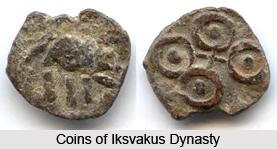 The earliest mention of the Andhras as a tribe is to be found along with the Savaras, Pulindas and probably also the Mutibas, in the Aitareya Brahmana where all these tribes are referred to as dasyus or non-Aryans. In the Shatapatha Brahmana also, the Andhras are mentioned along with the Pundras, Savaras, Pulindas and the Mutibas. It has been said that that the Andhras were Dravidian-speaking people and were evidently the progenitors of the modern Telegu-speaking people occupying the deltas of the Godavari River and the Krishna River. In another historical record it has been said that Andhras were originally a Vindhyan tribe that extended its political power from the west gradually to the east down the Godavari and the Krishna valleys. Both Mahabharata and Daksina-patha-janmanah has said that the Andhras were from the Deccan region while the Ramayana said that were the from the Godavari region.
The earliest mention of the Andhras as a tribe is to be found along with the Savaras, Pulindas and probably also the Mutibas, in the Aitareya Brahmana where all these tribes are referred to as dasyus or non-Aryans. In the Shatapatha Brahmana also, the Andhras are mentioned along with the Pundras, Savaras, Pulindas and the Mutibas. It has been said that that the Andhras were Dravidian-speaking people and were evidently the progenitors of the modern Telegu-speaking people occupying the deltas of the Godavari River and the Krishna River. In another historical record it has been said that Andhras were originally a Vindhyan tribe that extended its political power from the west gradually to the east down the Godavari and the Krishna valleys. Both Mahabharata and Daksina-patha-janmanah has said that the Andhras were from the Deccan region while the Ramayana said that were the from the Godavari region.
Andhras were specifically a tribe from the southern part of India. The Andhras have been mentioned in the Udyoga Parva and Bhisma Parva of the Mahabharata as Andhakas and Andhras respectively. And according to the Sabha Parva and Vana Parva the Andhas or Andhras were rude uncivilised people.
History says that tribes like the Andhras, the Palidas, the Bhojas and the Rathikas were vassal tribes of the Maurya. It is mentioned that the Andhras possessed a very large number of villages; thirty towns defended by walls and towers, and supplied their king with an army of 100,000 infantry, 2,000 cavalry and 1,000 elephants.
The Satavahanas are claimed by the Puranas to have been Andhras or Andhrabhrtyas. According to history the Iksvakus succeeded the Satavahanas in the rule of the Andhra region where almost all the records of the dynasty have been found. The Purana claims that the Andhra dynasty had five different branches. In fact, one of these five branches, namely, the Cutusatakarni branch, is known from inscriptions, coins and literary references to have ruled in the Kuntala country before the Kadambas.
Huen-Tsang has recorded that the Andhras were very different from that of central India. They used a kind of speech which was different from that of Mid-India and there were some Buddhist monasteries in the land of the Andhras. He had said that the people of the Andhras were black in complexion, were of violent disposition and were fond of the arts.



















